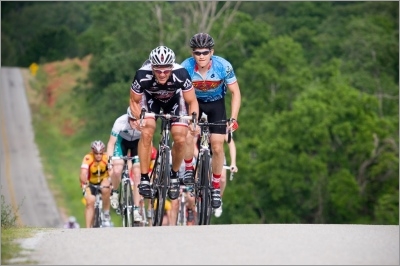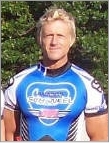 | ||
| ||||||||
By Alex Fedak
Alex Fedak leading the peloton. photo courtesy Alex Fedak In my opinion, cycling is a perfect cross-training tool for skaters. It builds cardiovascular capacity. It sharpens your racing skills. And due to its popularity, it offers a social element that is often lacking in skating. So how do you get started as a cyclist? Buying a bike First, you need a good road bike. Road bikes come in a large assortment of flavors and sizes. So if you are new to the sport, head over to your local bike shop and check out the options. You’ll find bike shops — unlike skate shops — in most towns of any size. And those bike shops are typically staffed by experts who can make sure you get the right size bike and adjust the seat and handlebars to fit your dimensions. If you prefer to shop online, check out the many industry websites, including the sites of two of my sponsors, Cannondale and SRAM. Make sure you get the right size bike. The bigger you are, the bigger the bike you’ll need. You can find size charts — like this one — online. You can save money by buying a used bike on eBay or Craigslist. But be sure you know what you are doing. Besides a bike, you’ll need some bike shoes. (Yep, cycling is an equipment intensive sport.) Bike shoes have cleats that attach to the pedals. That way, you are pushing the pedals even on the up-phase of your stroke. Expect to spend anywhere from several hundred to several (or more) thousand dollars on a road bike. A friend of mine recently bought a nice starter bike, complete with clipless pedals and shoes, for $800 at a local bike shop. The staff adjusted the seat and handlebars to make sure it was just right for him. So it was a pretty sweet deal. Training partners Once you’ve got your bike, you’re ready to ride. You can choose to pedal alone. But it’s a lot more fun — and productive — to ride with a group of cyclists. Look for lists of local cycling clubs, teams and group rides at your local bike shop or online. You’ll find rides for recreational cyclists, fitness riders, and serious athletes. If you’re serious about racing, go with the last group. Go for a ride with your group and see how it works out. If it’s not right, try another group. With so many rides available, you should be able to find one that is right for you. If you ride with a competitive group, you’ll get some great training for skate races. Typically, training rides get competitive. And competitive cyclists use most of the same race strategies we use: drafting, attacks, breakaways, etc. So you can get some good race experience without traveling half way around the country to a skate race. My training and racing with cyclists has polished my ability to read pelotons, work with teammates, and react instantly to breakaways. And all in the low-pressure atmosphere of a training ride. How can you beat that? How much cycling?
During the offseason, I typically ride two or three times a week. Each time I usually log between 60 and 80 miles. And once a week or so, I’ll go for one ride in the nearby mountains to get some hill work. I also compete in local and regional bike races. Once the skate season starts, I cut back on cycling and do more training rides that are shorter in length but higher in intensity. Of course, I’ll also start skating more, and as the racing season approaches, I’ll do more interval and technique work. But I keep cycling all year long. And why not? It may not be as fun as skating. But almost. ---
Related reading: • Skate Tip of the Week Archive
...
Copyright © 2011 Inline Planet | ||||||||



